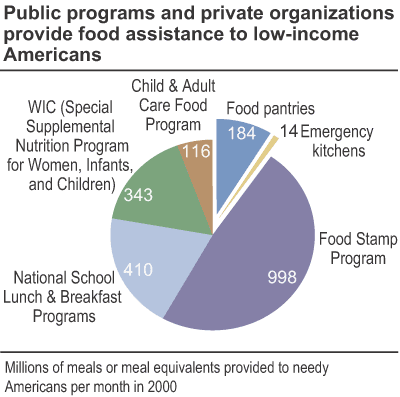Emergency Food Providers Supplement Federal Aid
- by Laura Tiehen
- 4/1/2003
During times of need, many households turn to local, nongovernment emergency food providers. Yet only limited information about these organizations has been available to policymakers. A recent ERS-funded study of emergency food providers estimates that almost 33,000 food pantries and over 5,000 emergency kitchens operate in the United States, and they provided an estimated 2.4 billion meals in 2000. The study is the first to provide a broad, national overview of these private, nonprofit organizations and their relationship to Federal food assistance programs.
Food pantries and emergency kitchens (often called soup kitchens) provide food directly to needy households. Food pantries distribute bags of food to be prepared and eaten at home. Emergency kitchens provide prepared meals that are eaten onsite. Food pantries and emergency kitchens are typically locally based and rely heavily on volunteers. Almost two-thirds are affiliated with a religious organization.
About 30 percent of food pantries and 40 percent of emergency kitchens in the 2000 survey had been in operation for more than 10 years. But, almost one in five emergency kitchens and one in three food pantries had been operating for 3 years or less.
Most food pantries and emergency kitchens receive at least some of their food from food banks, which collect mostly nonperishable food in bulk from private and government sources. Food pantries and emergency kitchens may also receive food from food rescue organizations, which recover perishable food from foodservice operations, food retailers and wholesalers, and farmers.
Emergency food providers offer a valuable service in many communities, but the amount of food they distribute is small relative to Federal food programs. Food pantries and emergency kitchens provided an estimated 198 million meals per month in 2000. In contrast, the five largest Federal food assistance programs provided the equivalent of 1.9 billion meals per month in 2000.Many emergency food providers receive and distribute USDA commodities to households, mainly through The Emergency Food Assistance Program (TEFAP). Roughly 85 percent of food banks receive USDA commodities, such as fruit, vegetables, meats, and rice, and about half of food pantries and emergency kitchens report using USDA commodities. Emergency food providers distributed about 422 million pounds of USDA commodities in 2000, which accounted for nearly 14 percent of all food distributed by them.
This article is drawn from:
- The Emergency Food Assistance System—Findings From the Provider Survey, Volume I: Executive Summary. (2002). USDA, Economic Research Service.


